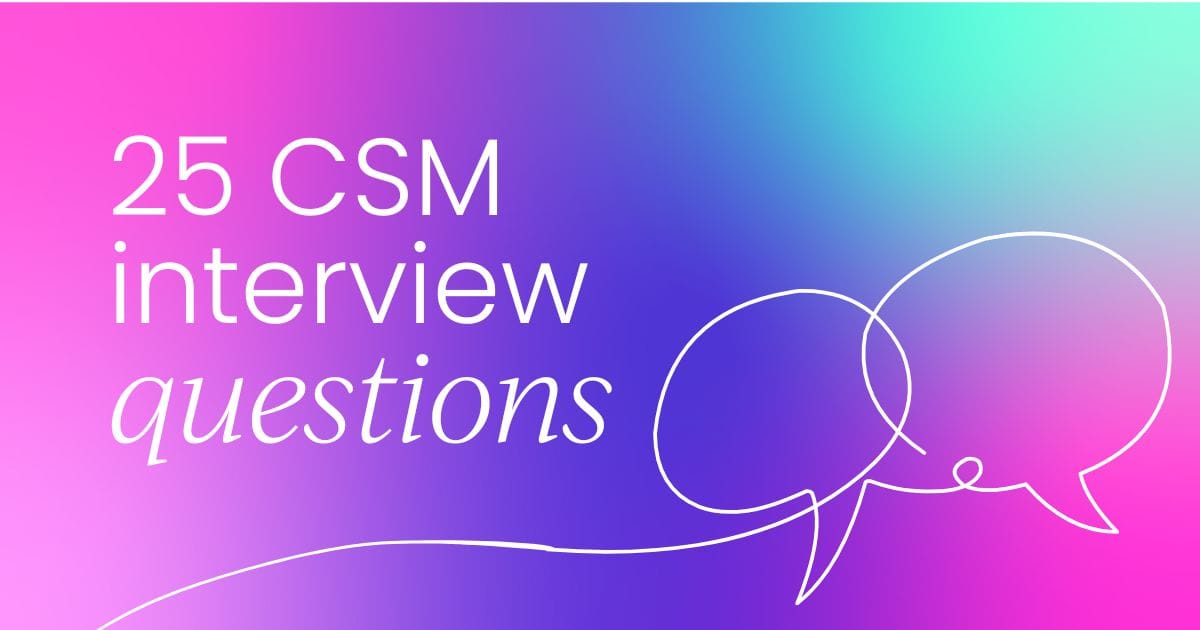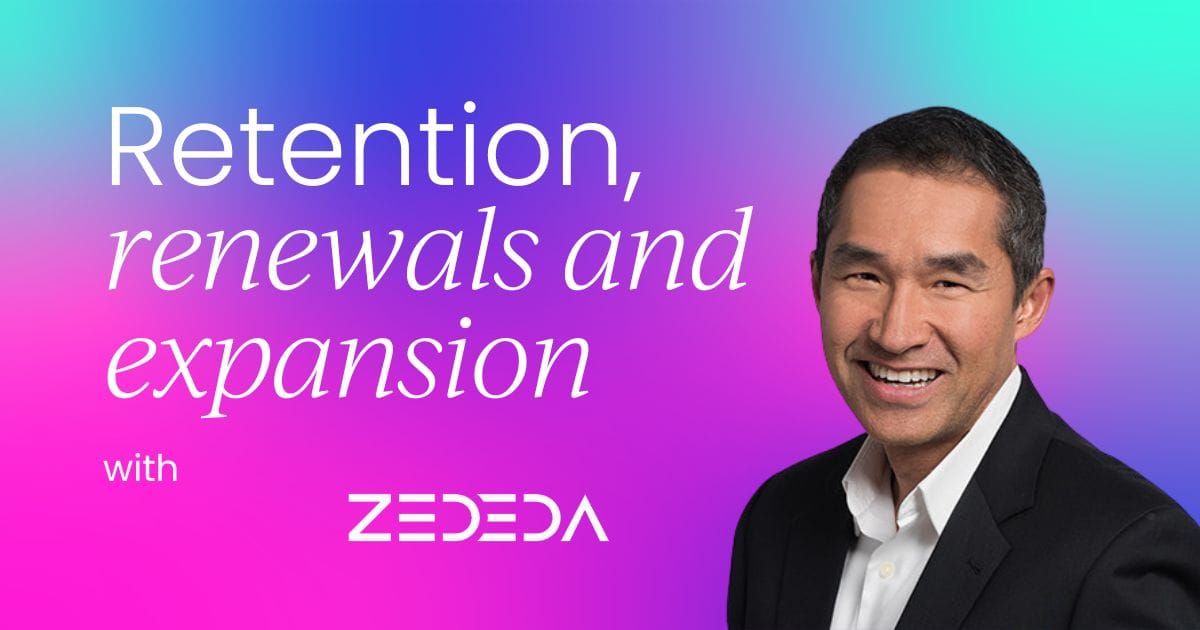This article is based on a presentation given by Brady at our Customer Success Festival in Austin, 2024.
Catch up on this presentation, and others, using our OnDemand service. For more exclusive content, visit your membership dashboard.
Driving customer retention and growth is critical.
One of the most powerful tools I've seen in action is win-loss analysis – a method that can lead to significant improvements in retention, expansion, and overall customer satisfaction.
In this article, I’ll explore how win-loss analysis can fit into your broader customer success (CS) objectives. I’ll discuss how and when to conduct win-loss analysis within the customer journey, and share some practical tips on how you can get started.
It doesn’t always have to be a CS initiative, but there are many ways to integrate it into your operations.
The importance of feedback for win-loss analysis
Before diving deeper into win-loss analysis, I want to share a brief story that really hit home for me.
About a year ago before I joined Clozd, my wife and I went to our favorite restaurant. This visit turned into one of those “I get it –this is why this is important” moments for me. We ordered, but when my meal arrived, the dish didn’t meet expectations.
Now, I don’t do confrontation. My wife, however, is not afraid to speak up. So she politely let the waitress know it wasn’t what she had in mind. The waitress brought out another salad, but it was essentially the same. At this point, I was hoping she wouldn’t say anything more. But my wife raised her hand again, and eventually, the chef himself came out.
You can imagine my embarrassment when I saw him. I thought, “We’ve offended this poor man.” But I’ll never forget what he said next: “I saw what they brought out, and I am so embarrassed.” He then presented a brand new meal –this time perfectly cooked.
This experience was pivotal for me. It made me realize how often, as leaders, we have a vision of what we think will happen in our go-to-market approach –whether it’s with our sales team, CS team, or any other part of the organization. But reality doesn’t always match that vision. Sometimes, despite our best intentions, we end up with cold Brussels sprouts in our salad, so to speak.
In that moment, my wife was the kind of person who spoke up and gave the restaurant a chance to make things right. But if it had been up to me, I probably wouldn’t have said anything. And that’s where win-loss analysis comes in.
Win-loss analysis is the voice that speaks up, giving your company a chance to make things right. It involves engaging a third party– whether someone within your company or an external partner –to help you understand why you’re winning or losing deals.
The evolving role of post-sale teams
Over the past 24 months, the post-sale landscape has changed significantly. Boards and leadership teams are increasingly looking to post-sale teams to help counteract the effects of economic downturns.
This shift has likely felt very familiar –you're being asked to do more with less.
Perhaps you've been told to improve net retention while also managing a team that's 20% smaller, with each rep now responsible for more annual recurring revenue (ARR) per head. It's a classic case of conflicting priorities: you can focus on one, but doing both simultaneously seems nearly impossible.
This is where win-loss analysis becomes crucial. Originally, win-loss analysis was a tool designed for sales teams. Our two co-founders created this product to help sales leaders understand why they were winning or losing new business deals. However, as CS teams have become increasingly involved in revenue-facing conversations, win-loss analysis has naturally evolved into a CS responsibility as well.
Now, many of you are being asked to take ownership of net retention numbers, manage expansion targets, or even hold quotas within your own teams. This means that understanding why you're winning or losing is no longer just a sales issue – it's your issue too.
Why are some customers churning while others expand? Why do some deals close while others fall through? Let’s break down these problems using win-loss analysis.
The core of win-loss analysis
To put it simply, win-loss analysis is the systematic practice of analyzing why you win, lose, retain, or churn customers.
If you think about the customer journey, there are numerous touchpoints where you might either win or lose someone. It's similar to how you might track an opportunity in Salesforce or HubSpot – whether it's an expansion opportunity or a renewal, there are key moments along the journey that determine the outcome.
One of the common questions I get is, "We already have great relationships with our customers and talk to them regularly. What could they possibly tell you that they wouldn't tell us?" This brings me to a little game I like to call, "Who said it: Was it from the TV show Succession or a closed interview?"
I have to admit, we get some pretty brutal feedback in these interviews. Let me share a few examples:
- "I don’t need a high-pressure sell on this [expletive]. You’re not my boss. Stop trying to pressure me."This was actually from a closed interview.
- "No one explained [product] to me. No one said, ‘Hey, I’m sorry, we’ve had a little bit of a crisis going on here.'"Again, this was from a closed interview.
- "We don’t know who the [expletive] you are."Yes, that was from a closed interview as well.
In one instance, we conducted an interview where the person on the other end of the deal said that the sales rep she had been working with was misogynistic and that she would never work with that company again because of how she was treated during the process. You can imagine the shock of the CEO when he read this interview
He personally reached out to her, deeply apologizing because he cared – he’s like the chef in the restaurant who takes pride in what’s being served. He wasn’t trying to change her mind but genuinely wanted to apologize for the experience she had.
This example highlights a crucial point: when customers talk to someone who isn’t directly involved in the sales or service process, they tend to be much more blunt about what’s happening. This honesty can provide you with incredibly valuable insights that might not surface otherwise.
While companies like Clozd can conduct these interviews on your behalf, some businesses choose to have someone from Product Marketing or another role —someone not directly customer-facing— handle these conversations. Regardless of who conducts the interviews, the key is to gather these candid insights that can significantly impact your understanding and strategy.
The changing landscape of customer journeys
Customer journeys have become far more nuanced in recent years, particularly over the last 24 months. A few years ago, these journeys were often straightforward, characterized by growth and upsell opportunities. Everything seemed positive, and it was mostly about upselling and expansion.
However, today’s customer journeys look quite different.
Now, it’s common to experience a scenario where a customer who initially decided not to go with your product comes back later, acknowledging their mistake and deciding to sign up. They start strong, fully utilizing your product during onboarding, and for the first six months, everything looks great. Health scores are up, and you’re confident in your relationship with them.
Nine months in, you pitch an adjacent product line, but they decline. You shrug it off – everything else still looks good, and they renew at the 12-month mark. But then, at month 18, out of nowhere, you get an email from their procurement team notifying you of their intent to cancel. You're left wondering, "What happened?" because all the signs had been positive up until that point.
This is where win-loss analysis can be a game-changer. Conducting interviews at various points in the customer journey, especially later on, can provide valuable insights that might not be obvious from traditional metrics.
Types of lin-loss interviews
There are several types of interviews that can be conducted throughout the customer journey. Each serves a different purpose and can uncover unique insights that help you understand what's really going on with your customers.
New business interviews:
These are conducted early in the deal process, typically after a lost deal. While they may not be directly relevant to CS from a retention standpoint, they provide valuable information about what went wrong on the sales side.
For instance, a customer might say, "We were mainly looking to help fix our Q4 pipeline." If CS isn't aware of this specific need, they might focus on solving a different problem, missing the customer's key pain point. Understanding these gaps can help ensure that your team has the right account plan in place from the start, setting the stage for a successful renewal.
Customer experience or voice of the customer interviews:
These interviews are often conducted at the four- to eight-month mark, midway through the contract. They’re designed to gauge how things are going so far, offering a snapshot of the customer’s experience.
For example, a customer might reveal, "The implementation of [product] has been an absolute nightmare." Despite what your usage metrics might show, feedback like this can signal serious red flags, giving you the opportunity to address issues before they lead to churn.
Expansion interviews:
These come into play when a customer chooses not to expand or purchase additional products. In one case, a customer might say, "I just don’t really see [your company] as a player in that space." This feedback isn’t necessarily a failure on the CS side; it could indicate a marketing or messaging problem.
Understanding this helps you determine whether the issue lies with the perception of your product, the way it was pitched, or whether a more targeted marketing campaign is needed to educate customers on why your solution is the right fit.
The value of win-loss analysis in the customer journey
Win-loss analysis, when applied at different stages of the customer journey, provides crucial insights that go beyond the surface. Whether it’s understanding why a customer didn't expand, identifying misalignments during implementation, or pinpointing the exact reasons behind a lost deal, this tool equips you with the knowledge needed to proactively address issues, improve customer satisfaction, and ultimately drive net retention.
As customer journeys continue to evolve, integrating win-loss analysis into your strategy becomes increasingly important. It allows you to stay ahead of potential problems, ensuring that your team is well-prepared to deliver the value your customers expect at every stage of their journey.
Insights from renewal and expansion win interviews
When conducting renewal win interviews, it's always gratifying to hear positive feedback about our CS teams. For example, you might hear things like, "I love working with Scott. He's the best." While it's great to receive praise, it's important to dig deeper into these comments to understand the full context.
Consider this quote from a renewal win interview: "I actually like [competitor's] system a lot better. My Account Manager is pretty much the only reason I renewed. If that person leaves, I will probably leave as well."
At first glance, it might seem like you're in a good spot —after all, the customer renewed. However, this feedback reveals a significant risk: the customer’s loyalty is tied almost entirely to one individual. If that account manager were to leave, the customer might follow suit. This highlights the importance of multi-threading your relationships within the account, ensuring that the customer is engaged with multiple people on your team, not just a single point of contact.
The importance of expansion win interviews
Expansion win interviews are particularly valuable because they directly impact Net Revenue Retention (NRR). While growth from new sales is important, the real driver of NRR is often these expansion wins. These interviews provide insight into what is working and what could be improved in your strategy.
For instance, in one interview, a customer mentioned their relationship with both the sales and CS teams: "One thing that gets frustrating is that there's always a sales element when we meet. They’re always communicating other products and services, which can be helpful, but it also tends to get a bit old when you just want to have a meeting."
As a CS leader, this feedback presents a dilemma. On one hand, the customer did what you wanted—they expanded their use of your products. On the other hand, the constant sales pitch might be wearing thin.
The key here is to assess whether this sentiment is consistent across multiple interviews or if it's an isolated case. If many customers express similar frustrations, it might indicate a broader issue that needs addressing. However, if it's a one-off comment, it might not require a significant change in strategy.
The value of consistent feedback
The power of win-loss interviews lies not just in the individual anecdotes but in identifying patterns across multiple interviews. While saving a single customer based on specific feedback is valuable, the real strength of these interviews comes from understanding the bigger picture.
Are certain issues recurring across different accounts, or are they isolated incidents? This broader understanding helps you make informed decisions about whether to adjust your approach or continue with your current strategy.
By consistently gathering and analyzing feedback through win-loss interviews, you can ensure that your team is not only addressing individual concerns but also staying ahead of potential challenges that could impact your overall retention and expansion efforts.
The power of unified feedback: Addressing issues as a team
One of the most powerful aspects of win-loss analysis is how it unifies the entire executive team, helping us move away from the typical finger-pointing that can occur when things go wrong.
It's much like the advice given by marriage counselors: instead of you and your spouse facing off against each other, you should place the problem on the other side of the table and face it together as a team.
Breaking the cycle of finger-pointing
In business, too often we blame each other when things don’t go as planned. Maybe a product feature doesn’t get released on time, and sales blames product, while product turns around and blames sales. It becomes a cycle of finger-pointing that doesn't lead to constructive solutions.
With a tool like Clozd, however, the dynamic changes. It places the entire executive team on the same side of the table, with the problem on the other side. The focus shifts to understanding what the customer is saying, and importantly, you can’t argue with the customer’s perspective—if that’s their reality, then it’s your reality too.
Real customer feedback
Consider this feedback from a customer: "[Company]'s UI is a dumpster fire. It is a complete disaster. It doesn’t flow, it’s nonsensical. I’ve been in this space for a long time as a systems admin and as a consultant.
I’m constantly working in different systems, and they all have some level of parity in how you accomplish things. [Company] just seems to think they’re special or something. I don’t know who dreamed up the UI, but it is just horrible."
As a CS leader, if you’re dealing with a net retention problem and you see UI being brought up repeatedly in churn interviews, this feedback becomes a powerful tool. You can go to your product team with concrete evidence: "Hey, I know we’ve discussed this before, but I can point to 30 individual deals where UI issues were explicitly mentioned as a reason for not renewing." This isn’t just an isolated complaint; it's a pattern that’s impacting the business.
Building a non-confrontational case
Even in renewal interviews, where a customer might renew for various reasons, if they still mention UI as a negative factor, it adds weight to your argument. The strength of this approach lies in how it enables you to present feedback in a non-confrontational way. Instead of a "he said, she said" situation, you’re bringing clear, customer-driven insights to the table that the entire executive team can rally around.
When the customer’s voice is at the center of the discussion, it aligns everyone’s efforts toward improving the product and the customer experience, leading to better outcomes for both the team and the company.
Challenging assumptions
One of the exercises I like to run with our customers is what I call the "What would you have to believe?" game. This thought experiment helps us uncover the assumptions that might prevent a company from implementing win-loss analysis.
To decide against win-loss analysis, you'd have to believe several things that are, frankly, unrealistic for most companies:
- Perfect execution in your go-to-market strategy
You'd have to believe that there are no underwhelming restaurant meals in your go-to-market motion –that every single playbook you've created is executed perfectly every time. For most of us, this simply isn't the case.
- Customers who always speak up
You'd need to assume that your Customer Success Managers (CSMs) are only dealing with people like my wife, Mary – customers who are always willing to speak up, even in a long-term relationship. In reality, it's much easier for customers to voice concerns in a one-time transaction, where the stakes are low and they can leave a review without ongoing interaction.
But in a long-term relationship, such as monthly or quarterly business reviews, customers are often reluctant to introduce friction by voicing their dissatisfaction. They might fear that speaking up could negatively affect the service level they receive for the rest of the contract.
- CSMs who proactively admit mistakes
You'd have to believe that your CSMs will always proactively admit when they've made a mistake. This is a big ask. How often will a CSM come to you and say, "Just so you know, we lost this deal because I did a terrible job on the QBR"? It's much more common for people to point to external factors like budget or pricing rather than take personal responsibility for a lost deal.
- Consistent performance across the CSM team
You'd also have to assume that there are no outliers in your CSM team—that everyone performs consistently, and there's nothing to be learned from variations in performance. Even if you believe this, you'd have to be confident that you're already documenting and sharing insights perfectly across the team, ensuring that everyone learns from each other's experiences.
For most companies, these assumptions simply don't hold up. We're all busy, and it's difficult to ensure that every insight is captured and shared, every customer speaks up, and every CSM performs perfectly. This is why win-loss analysis is so valuable—it helps bridge these gaps.
What Clozd has done is create a system and software applications that allow everyone on the team to go in and review deals on their own. They can learn from the best-performing team members –like our hypothetical "Scott" –by seeing exactly what Scott’s customers say about their relationship with him. This opens up opportunities for discussion, where team members can approach Scott and ask, "I noticed this customer mentioned X, Y, and Z. How did you handle that? What did you do differently?"
This kind of insight sharing and discussion fosters a culture of continuous improvement and allows you to run a more effective and cohesive CS team. By using win-loss analysis, you're not just identifying where things went wrong; you're actively learning how to replicate success across your entire team.
Measuring success: The ROI of win-loss analysis
When implementing any strategy, especially one like win-loss analysis, the ultimate goal is to see tangible results. After all, any software or activity needs to be measured against its return on investment (ROI).
One of our customers perfectly encapsulated this in a quote I love: "What we've seen is just quarter over quarter, a massive improvement in retention—greater than 10% growth improvement quarter over quarter. I mean, like an actual 10% jump, not just 10 basis points or 10 percentage points, but a real 10% improvement."
This kind of result shows that the work we're doing is making a significant impact. It demonstrates that our customers are noticing the attention we’re paying to their problems, and they are responding positively.
Leveraging interviews for deeper insights
Another customer shared a similar sentiment, explaining how they run multiple types of interviews concurrently. They decided to take a closer look at their customer base as a whole, suspecting that there might be at-risk customers they weren’t fully aware of—perhaps because the health score didn’t reflect the true situation. Even for customers who weren't visibly at risk, they believed they could still gain valuable insights by engaging in these conversations.
This particular customer conducts a variety of interviews, including new business win interviews, CX or midpoint check-ins, and churn analysis. However, due to budget constraints, they’ve chosen not to interview their entire pipeline.
Instead, they use surveys or other lower-cost alternatives for parts of their pipeline, focusing their in-depth win-loss analysis on the most critical segments of the customer journey that impact net retention.
Identifying critical customer journey stages
This approach prompts us to consider our own customer journeys. Is your primary challenge a growth problem, a net retention issue, a lack of expansion, churn, or perhaps downgrades? Identifying where the problem lies within your customer journey is crucial to deciding where to allocate your win-loss interviews.
If you have limited resources, consider which customer segments or stages in the journey are most important. Is the highest churn occurring in enterprise, mid-market, or SMB customers? Are there specific regions or verticals where you're seeing more issues, such as healthcare versus tech or manufacturing? By conducting side-by-side comparisons across different industries or segments, you can uncover why you’re winning or churning in different contexts.
Approaching win-loss analysis with a curious, inquisitive mindset allows you to gain deep insights into your business. It enables you to make informed decisions about where to focus your efforts, ensuring that your strategies are data-driven and aligned with the actual needs and behaviors of your customers. This kind of targeted, thoughtful analysis is what drives meaningful improvements in retention and growth.
Turning insights into action
When companies conduct win-loss interviews, one of the most critical next steps is creating actionable plans based on the insights gathered.
For example, after completing an interview, the team will reach out to the customer and say, "Based on what we heard in this interview, we want to meet with you to discuss the feedback you provided." This isn't just a routine follow-up; it's a proactive effort to address concerns before they escalate.
Collaborative problem-solving sessions
In some cases, companies will organize what they call a "get well" or "win room" session, bringing together multiple departments to collaboratively solve the problem. This could include teams from product, support, sales, and customer success, all working together to figure out how to address the customer’s concerns and improve their experience before it’s too late. This cross-functional approach ensures that the solution is comprehensive and that all relevant stakeholders are involved in the process.
One of the surprising outcomes of this process is the goodwill it generates among customers. As one of our clients mentioned, "The goodwill we've seen from our customers is incredible. Partnering with Closed and investing in this area shows our customers that we genuinely care about them and are committed to their success."
This kind of investment demonstrates to customers that you're not just passively collecting feedback—you’re actively using it to make tangible improvements. It shows that you value their input and are willing to invest significant resources to ensure their satisfaction.
Overcoming internal resistance
Initially, there can be some resistance, particularly from sales reps, who may feel protective of their deals. They might worry that these interviews could disrupt or jeopardize their hard-won relationships. This concern is understandable; after all, sales reps are deeply invested in their customers and want to avoid anything that might rock the boat.
However, CS reps tend to be more open to collaboration. They’re used to working closely with other departments, such as support and product, to solve customer issues. Even so, both sales and CS reps share a common trait—they care deeply about their customers. This shared concern can be leveraged to gain buy-in for the win-loss interview process.
The value of an unbiased third party
One of the key advantages of bringing in an unbiased third party—whether it’s someone from Product Marketing or an external vendor—is that it gives customers a safe space to speak up. It allows them to express their true feelings and concerns without worrying about damaging their relationship with the primary point of contact.
This process encourages customers to be more like Mary (who speaks up when something is wrong) rather than Brady (who might stay quiet to avoid conflict). By giving them a microphone, you provide them with the opportunity to share what's really on their mind, which can be invaluable for making improvements that matter.
Ultimately, this approach not only helps in identifying and addressing issues before they lead to churn but also strengthens the relationship between you and your customers. It shows that you are committed to their success and are willing to go the extra mile to ensure they are happy and satisfied with your services.
The changing landscape of win-loss analysis
I know many of you are thinking, "Brady, I barely have enough time for my current responsibilities, let alone adding something new." And you're right —most of us are busy leaders with limited bandwidth.
However, there’s a crucial shift happening in the realm of win-loss analysis that I want to highlight, and it's something worth your attention.
One of the most significant trends we've observed in our 2023 State of Win-Loss Report is the shift in who owns win-loss analysis within organizations.
Over the last three years, there's been a notable change in ownership from being solely in the hands of product or executive teams to being more centered within revenue teams—specifically sales and CS. While marketing might still handle the day-to-day execution, it's the sales and CS teams that are increasingly holding the budget and steering the strategy around win-loss analysis.
When I talk about "owning" win-loss analysis, I mean the responsibility for deciding what types of interviews to conduct, how to act on the insights, and determining what really matters to your business.
Regardless of who technically owns the process, the ultimate goal is the same: achieving meaningful outcomes that drive business success.
Another critical trend is the transition from win-loss programs being project-based or department-specific to becoming ongoing, cross-functional efforts. This shift is reflected in the chart on the left, which shows a significant increase in cross-functional win-loss programs from 2020 to 2023.
What does this shift look like in practice? Typically, one department might sponsor the day-to-day aspects of the program, but the real magic happens in regular cross-functional collaboration.
For example, you might have monthly executive roundtables where each team reviews the last 10 deals to identify common trends and themes. Or, you might look at the data quarterly, analyzing insights from, say, 35 renewals to spot shifts in customer behavior or preferences.
These discussions are crucial for driving executive strategy, ensuring that decisions are informed by real, up-to-date insights from your customers.
The power of broad access to win-loss insights
The chart on the right of the image above demonstrates the impact of giving more employees access to win-loss insights. The vertical axis shows the percentage of employees with access to these insights, while the horizontal axis reflects the percentage of companies that saw an improvement in win rates in 2023.
The trend is clear: the more people within your organization who have direct access to why you are winning and losing deals, the better your overall outcomes.
When employees can explore the data for themselves—testing their hypotheses and learning directly from the insights—they become more engaged and better informed. This broad access leads to a deeper understanding across the company, reducing the need for top-down explanations and allowing for more organic learning and adaptation.
By embracing these trends—shifting ownership to revenue teams, making win-loss programs cross-functional, and giving broad access to insights—you can ensure that your company remains agile, informed, and ready to succeed in a competitive market.
Implementing and leveraging win-loss analysis
I want to touch on one final, but crucial, aspect of win-loss analysis. I've mentioned the different types of interviews you can conduct and how to choose which deals to analyze. However, the most challenging and often overlooked part is what you do after you've gathered all this valuable information.
The real challenge in win-loss analysis isn't just about conducting interviews—it's about what happens next. Once you've conducted a great interview, what do you do with that information? How do you ensure that it gets used effectively to drive change within your organization? This is where intentionality becomes key.
Storing and sharing insights
You need a solid strategy for storing and sharing the insights you gather. Having a centralized repository where this information is accessible to everyone in the company is crucial. This enables broad access to the insights, allowing employees across departments to review and learn from the data.
But access alone isn't enough. You must also have regular follow-up meetings where teams come together to discuss the findings and decide on concrete actions.
Accountability at the executive level
One of the trickiest parts of the process is ensuring accountability at the executive level. After gathering insights from win-loss analysis, it’s essential to have mechanisms in place to hold executives accountable for addressing the issues that arise. This might involve setting up regular check-ins or review sessions where the team discusses progress on implementing changes based on the feedback.
This area has seen significant advancements, thanks to new software tools in the win-loss space. These tools can help automate parts of the process, making it easier to track actions, assign responsibilities, and monitor progress—reducing the workload on your end and ensuring that the insights don’t just sit idle.
Options for implementing win-loss analysis
If you believe your company could benefit from win-loss analysis, there are multiple paths you can take:
- Running it internally: While time-intensive, running win-loss analysis internally can be highly effective if done correctly. It allows for greater control over the process and direct integration with your internal teams.
- Outsourcing: If internal resources are stretched thin, outsourcing win-loss analysis is a viable option. There are many tools and services available that can handle the heavy lifting, from conducting interviews to analyzing data and presenting actionable insights.
Finally, if you’re considering implementing win-loss analysis and need to convince your CFO or other stakeholders to approve the budget, focus on demonstrating the potential ROI. There are various metrics and case studies you can use to build a compelling case, showing how win-loss analysis can drive improvements in retention, win rates, and overall customer satisfaction.
Win-loss analysis is a powerful tool, but its value is only realized when the insights it generates are effectively used to drive change. By being intentional about how you store, share, and act on this information, and by leveraging the latest tools to streamline the process, you can ensure that your win-loss program delivers real, measurable results for your company.
Whether you choose to run it internally or outsource it, the key is to start with a clear plan and the commitment to follow through on what you learn.
















 Follow us on LinkedIn
Follow us on LinkedIn




